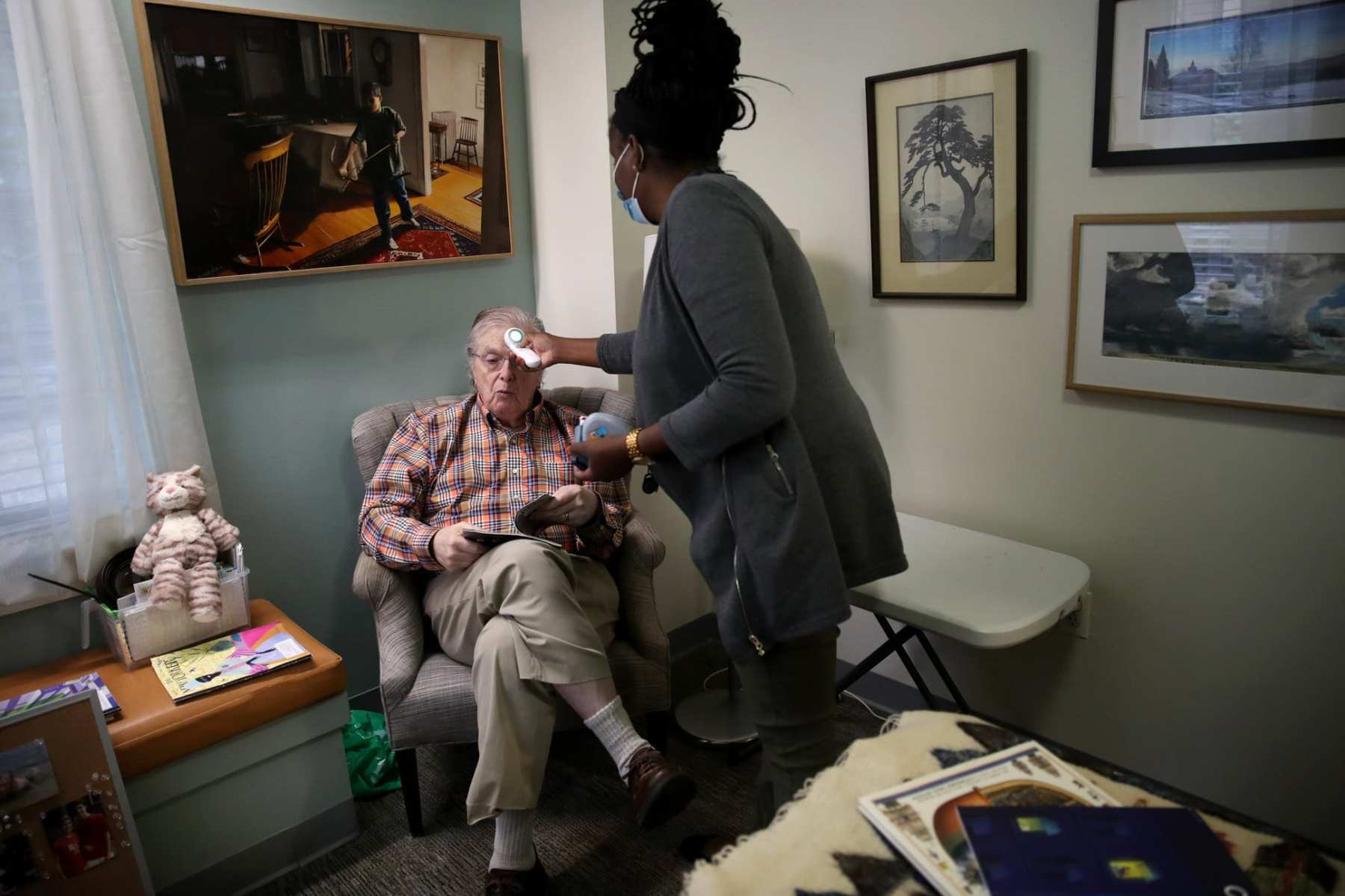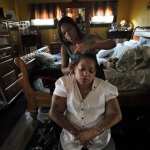President-elect Joe Biden’s ambitious, $775 billion caregiving plan has substantial support from voters — and particularly women of color — according to new polling first shared with The 19th.
The poll, released by the Service Employees International Union (SEIU) and the National Domestic Workers Alliance, found that 88 percent of voters surveyed were in support of Biden’s proposed 10-year plan that, if passed, would introduce free pre-kindergarten for 3- and 4-year-olds, boost pay for care workers and add an estimated 3 million care jobs.
Those are positions overwhelmingly staffed by women, who make up 87 percent of home care workers and 95 percent of the child care labor force. Black women and Latinas comprise an outsized share of this constituency, making up 80 percent of home health aides, personal care aides and nursing assistants and 39 percent of the child care workforce.
The work they perform is low-paying and often undervalued, with limited to no benefits in some cases. In 2019, the median hourly wage for home health workers was $12.15. For child care workers it was $11.65, according to the Bureau of Labor Statistics. This year has underscored the value of caregiving and proven how essential it is both in keeping people safe and keeping women employed in the workplace — women are more likely to leave the workforce if they do not have reliable access to child care. It’s no coincidence that nurses were among the first people to get vaccinated against the virus this week.
Polling found that concern about long-term care in nursing homes or at home was significant among voters at 43 percent, trumping other issues, including child care. The poll was conducted between November 25 and December 4 and paid for by SEIU, the nation’s largest health care union representing nearly 2 million members. It polled 1,319 voters, including 540 Black, Latina and Asian American and Pacific Islander women.
Biden’s plan has outlined expanded support for unpaid care, creating a $5,000 tax credit for informal caregivers and Social Security credits for people who care for loved ones, while also expanding funding for states and local entities to develop home- and community-based care and adding 150,000 community health workers.
Mary Kay Henry, the president of SEIU, said those plans wouldn’t just “lift up Black and Brown women, but the entire Black and Brown community and women of every race who do these jobs,” particularly those who have done it this year by working with the most vulnerable population for coronavirus: seniors.
“The amazing thing about this investment to me and what makes it so urgent is it impacts multiple problems at the same time: the virus, unemployment, and racial inequality,” Henry said.
Biden’s plan would devote $450 billion for elder care, specifically. The most sweeping component would wipe out the 800,000-person-long waiting list for home care and invest in community-based and at-home services. The SEIU poll found 75 percent of voters preferred home care over nursing homes.
The other prong of the plan would focus on child care, an industry where one in five workers have lost their jobs this year. Other than universal pre-K, the president-elect wants to subsidize child care for low- and middle-income families through an $8,000 tax credit for one child or $16,000 for two or more and incentivize businesses to build child care facilities on their properties.
For child care workers, Biden plans to increase pay to be on par with similarly qualified elementary school teachers, provide federally mandated paid family and medical leave up to 12 weeks, seven days of paid sick leave and affordable care for the workers’ own children. He’d pass the Domestic Workers’ Bill of Rights, a plan pushed by the National Domestic Workers Alliance that establishes labor protections for nannies, home health aides and others.
Child care has risen in the public consciousness this year as thousands of women were faced with increased child care needs when centers closed across the country. Many dropped out of the labor force because of it. In September, when school restarted virtually in many areas of the country, 865,000 women left the workforce.
But Ai-jen Poo, the co-founder and executive director of the National Domestic Workers Alliance, the nonprofit that does advocacy work for caregivers, hopes home care work will also be elevated in the conversation for child care. She said the two issues are interlinked.
“We are about to have the largest older population we’ve ever had, and the need for care is going to grow exponentially,” Poo said. “But we have really none of the infrastructure and systems and support in place to support caregiving.”
Given that the 65-and-older population is the fastest growing demographic in the country, if caregivers leave the industry — often to work in other low-wage jobs in retail or restaurants — the jobs and the demand still remain.And this is not work that can be automated or outsourced, Poo said.
“I would argue that in the 21st century we have to see care as infrastructure” she said. “What can be more fundamental than having strong caregiving programs in place to then enable people to go to work?”
Support for a caregiving economy is fairly bipartisan.
A poll by the First Five Years Fund, a childhood advocacy group, released in September ahead of the election found that 84 percent of voters found affordable child care to be an essential service. About 83 percent of voters in battleground states surveyed felt presidential candidates should have plans to address child care.
Republicans and Democrats have expressed support for various initiatives. The White House last year held a summit with leaders from both sides of the aisle focused entirely on child care and paid sick leave.
The tension point is around funding. A $775 billion price tag is expected to meet some opposition, regardless of which party controls the Senate following a run-off election in Georgia on January 5.
The Biden team has said the money will come from rolling back tax breaks for real estate investors earning more than $400,000 and ensuring the highest earners comply with stiffer taxes.
In the polling, voters showed some hesitation because of cost. Although 65 percent of voters polled said they felt care jobs should be fairly paid and that the Biden plan would help reach that goal, about 35 percent of voters said the cost was too significant given the current $3 trillion deficit. They worried that pay raises and benefits to workers will also raise the cost of care for seniors and people with disabilities.
But Henry argued the funding is there, it’s just gone to other priorities.
“It’s less money than we just gave to corporations in the last nine months,” she said. “It’s a fractured system now that’s causing problems for every family in the nation, and it’s high time we prioritize investing in women’s work that’s never been valued.”
Brittany Williams, a home care worker in Seattle, said her work was scaled back this year because she’s had to focus on her 8-year-old son whose classes have gone online. She’s down to working two days a week and gets by thanks to food donations from her church.
Williams makes $17.05 an hour thanks to a union contract, putting her slightly above the median wage of $14.76 for home care workers in Seattle. But the stress — of missing bills, riding the bus to work and wondering whether she or her son will get sick — has made for a punishing year.
Williams outlined those challenges for Biden during a roundtable discussion he held with frontline health care workers in November.
“Caregivers, we’re the maintainers of life,” she told him. “Caregivers were out there doing what had to be done, and we still are. We have to live with the [fear] in the back of our head.”
Reflecting on the call later, Williams said it was “humbling” to see so much focus put on care work for the first time.
“It’s time for essential workers to be respected,” said Williams, 34. “It’s beyond time that we are protected and we are paid on the level of what we give out as far as our value.”





